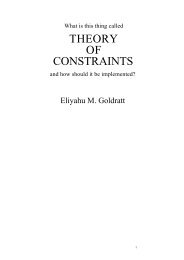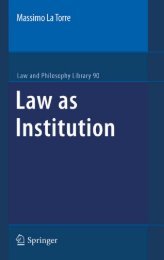Making of a German Constitution : a Slow Revolution
Making of a German Constitution : a Slow Revolution
Making of a German Constitution : a Slow Revolution
Create successful ePaper yourself
Turn your PDF publications into a flip-book with our unique Google optimized e-Paper software.
42 • The <strong>Making</strong> <strong>of</strong> a <strong>German</strong> <strong>Constitution</strong>understanding the Reformation as, predominantly, a legal rupture. The jurisdiction<strong>of</strong> ecclesiastical courts, as Berman writes, was one the <strong>of</strong> the principle objects <strong>of</strong>attack during the Reformation. 77 Witte argues effectively that the Reformation wasa ‘watershed in the flow <strong>of</strong> the Western legal tradition’. 78 Its radicalism was not inLuther’s posting <strong>of</strong> the Ninety-Five Theses in 1517, but the Wittenberg bonfire <strong>of</strong>10 December 1520. Organized by Philipp Melanchthon and others, Luther, along witha group <strong>of</strong> students and faculty, consigned to flames the papal bull threatening himwith excommunication, Pope Gratian’s Decretum and, most importantly, the fourbooks that made up the classical canon law. 79 In an environment in which the Churchalready faced local rejection <strong>of</strong> its secular jurisdiction, it was this that distinguishedLuther from earlier agitators, and it was this that formed the source <strong>of</strong> his swift excommunicationon 3 January 1521.A constitutional ideology developed around the battle over canon law, givingrise to an evangelical jurisprudence. This was evident in the Wittenberg School <strong>of</strong>Philipp Melanchthon, which became influential in seventeenth-century Denmark,and the Marburg School <strong>of</strong> Johannes Eisermann and Johann Oldendorp, more influentialin England. 80 Although erudite knowledge <strong>of</strong> the classics was apparent intheir writings, both Eisermann and Oldendorp had practical experience with localmunicipal legal structures. Eisermann served as a Schöffe on the Marburg H<strong>of</strong>gerichtand his On the Common Good <strong>of</strong> Ordering a Commonwealth (1533) was translatedand printed in London in 1559. It emphasized building on the lessons <strong>of</strong> the classicalcommonwealths, and that history taught that ‘there is not a single foreordained ornatural system <strong>of</strong> society, politics, and law’. Rather ‘every people chooses its ownsocial form, its own political structure, and its own system <strong>of</strong> law’ based on a ‘combination<strong>of</strong> nature, custom and reason’. 81 Originally from Hamburg, Oldendorp hadhelped draft the Rostock legal reformatio <strong>of</strong> 1530 and published some sixty workson law, including What is Equitable and Right (1529), A Statesman’s Mirror <strong>of</strong> GoodPolicy (1530) and A Methodology <strong>of</strong> Natural, Common and Civil Law (1539). Inhis writings, Oldendorp emphasized the preference for the nonviolent resolution <strong>of</strong>disputes. ‘War is justified only for defense against an unjust attack,’ and a civil polityshould seek to settle conflicts peaceably. 82 Since peace was so linked to law in the<strong>German</strong> tradition, this also <strong>of</strong>fers additional evidence <strong>of</strong> the continuing strength <strong>of</strong>the dual conception <strong>of</strong> law in <strong>German</strong> political thought.By the late sixteenth century, a power vacuum had resulted from the Reformation.This produced, in Dutch and <strong>German</strong> political thought, a preoccupation withthe location <strong>of</strong> the suprema potestas (sovereignty) and the rights and duties <strong>of</strong> political<strong>of</strong>fices. Debate was provoked by Jean Bodin’s conceptualization <strong>of</strong> sovereignty<strong>of</strong>fered in his Les six livres de la république (1576). While there was littledispute with Bodin’s view that legislative authority was the first mark <strong>of</strong> sovereignty,his insistence that sovereignty was indivisible and that this indivisibility renderedimpossible the existence <strong>of</strong> a respublica mixta (mixed constitution) was met withstrident objection. The mixed constitution referred to a mixture <strong>of</strong> the three pure




